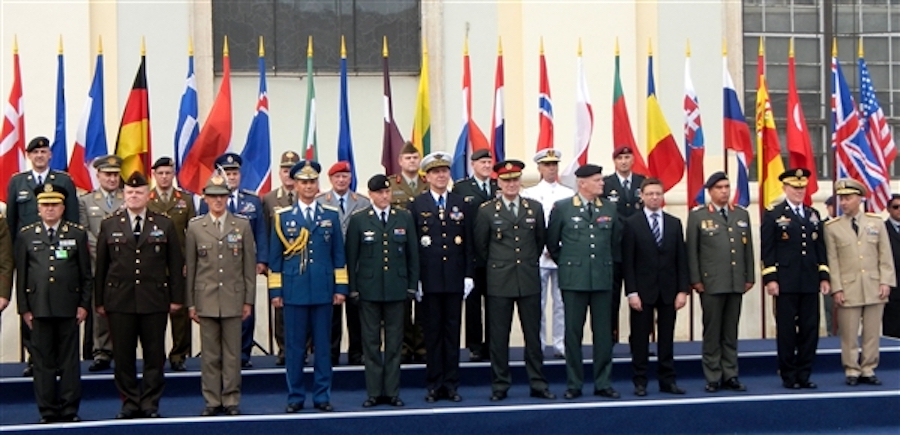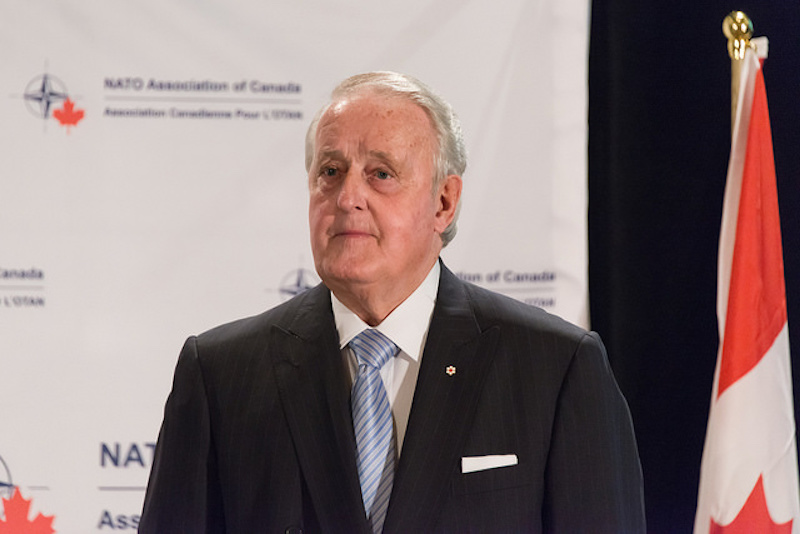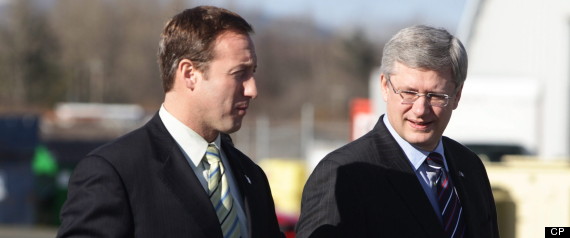This week saw the first NATO meeting of both 2017 and President Trump take place amidst an ongoing Russian modernization program to upgrade their nuclear weapons, initiated in 2014. NATO’s current deterrence posture is based on three documents: Strategic Concept (2010); the Deterrence and Defense Posture Review (2012); and the Warsaw Communique (2016). Although Russia’s target of updating 100% of its nuclear forces by 2020 seems unlikely, NATO members must use Russia’s modernization as an impetus to revisit NATO’s own nuclear forces and deterrence posture. While no final communique was issued, it would have been prudent to use the summit as a base for launching a nascent strategic review of NATO’s deterrence posture.
NATO’s 2016 summit in Warsaw once again reaffirmed that a large part of NATO’s current deterrent depended on American tactical nuclear weapons forward-deployed in Europe. The Warsaw Communique made explicit reference to the presence of these weapons in Europe. Today, the United States is estimated to have based approximately 200 B-61 (models 3, 4 and 10) gravity bombs, based in 5 different countries in Europe, which constitute a direct political and military link between Europe’s safety and American commitment to it. The conventional wisdom for the continued stationing of tactical weapons in Europe is centered on the notion that these weapons possess a deterrent capability that strategic weapons (like America’s LGM Minuteman ICBM missiles) lack. Lower warhead yields, more flexible delivery systems, and limited use in a conventional battle, in addition to the political reassurance provided to allies by America’s stationing of these weapons on European soil, continue to serve as the rationale for a deterrent posture that, even in peacetime, is contingent on forward-deployed tactical weapons. Despite the multiple problems posed by such a posture, especially the domestic political complications created for nations on whose soil these weapons are stationed (ie. Belgium, Netherlands, Italy and Germany), NATO seems unwilling to contemplate an alternative deterrent posture.
What are the problems?
Various problems confronting NATO member states, especially those on whose soil American weapons are based, might become severe enough to force a reevaluation of NATO’s deterrence posture due to its potential unsustainability. One of the concerns consuming the attention of member states is that of modernization. In NATO jargon, modernization has become the epithet endowed to the longstanding issue of Dual Capable Aircrafts (DCAs). Without DCA’s like the F-15 E or the F-16 NATO would lack the capability to carry and deliver the payload of the B-61s. Modernization of DCAs is a sensitive subject of discussion between NATO members, especially those members who are currently utilized as bases, because European public support for all issues nuclear are very low and parliamentarians, dependent on public support for re-election, do not wish to inflame public opinion by raising the issue. Some countries are even contemplating retiring the aging F-15 E or F-16 fleet instead of upgrading by purchasing the new F-35 Joint Strike Fighter (JSF) which was specifically designed to carry the modernized B-61 12 bomb. This would mean another country possessing the necessary capabilities (which will soon mean having a DCA F-35 Lightning) must assume the burden. Another problem relates to the security of the bases in which these weapons are based, particularly the Incirlik air base in Turkey which is suffering from instability and has led to speculation that the weapons stored there may be moved to Romania. The terrorist attack on Belgium soil, a basing nation, in 2016 also raised questions about the vulnerability of the American stockpile should terrorists be able to gain access to the sites in which they are based. In general, a review conducted by the Air Force Blue Ribbon determined that most bases in Europe do not meet the Department of Defense’s security standards.
Why update now?
In the event that problems inherent in NATO’s current deterrent posture do not impel it towards reviewing NATO’s strategy, Russia’s modernization program certainly should. The recent recrudescence of tensions between the alliance and Russia, with respect to Ukraine and Syria, have unfolded against a backdrop of worrying moves by Russia that can potentially undermine NATO. Russia, since around 2000, has been incorporating simulations of tactical (limited) nuclear strikes in all of its large-scale military exercises. More recently, Russia has acquired a habit of conducting ‘snap exercises’ that are unannounced, without the presence of NATO observers, and involve heavy weaponry, including ballistic missiles. These reports align with and supplement the Russian nuclear doctrine of ‘escalate to de-escalate’, which places a heavy emphasis on the threat or actual use of tactical weapons, in order to extend ‘credible deterrence down the escalation ladder’. Even if Russian policymakers envisage a high threshold for the use of any nuclear weapons, Russia has been actively promoting the threat of using these weapons and has also been conducting the necessary exercises to prepare for their use. Russia is aware that the less reliable its conventional forces are, the greater the emphasis it has to place on nuclear weapons to compensate for that shortcoming and Putin is ostensibly making an effort to align Russia’s doctrine with its capabilities. NATO should not allow itself to become trapped in a situation where Russia can coerce NATO to conclude a conventional battle by tactical weapons because if Russia is able to do so, the subsequent political settlements that must follow will certainly not favor NATO and the countries involved.
An opportunity?
The gathering of NATO heads of state on May 25 presented a propitious possibility for contemplating some of these problems. Since the nuclear weapons most important to NATO’s deterrence posture are those of the United States, it is natural that America assumes an assertive attitude in guiding NATO allies towards a recalibration of both NATO’s doctrine and capabilities. Procedural conventions preceding the adoption of an alternative deterrence posture, acquiring consent from other allies, and adjusting existing programs and capabilities to implement changes in strategy is obviously a long term project. This process, however, should motivate, not deter, NATO, and America in particular, to shift the current NATO debate about the role of DCAs to a discussion on NATO’s general deterrence posture. In Trump’s speech to the heads of state of other NATO allies, only a fleeting reference to modernization and readiness was made and nothing specific at that. Despite the significance of DCA’s in NATO’s deterrent posture it is important for NATO to find alternatives to a forward-deployed deterrence posture. So long as discussions in NATO are centered on and revolve around DCA’s, it is likely that the status quo continues.
New weapon same problem?
What further reinforces the notion that America, and NATO, will continue to rely on tactical nuclear weapons (although, importantly, not necessarily forward-deployed) is the life extension program (LEP) of the B-61 initiated by President Obama to modernize and replace all existing B61 models in stationed in Europe with the B61-12. What makes the B61-12 special is its variable yield function which allows a dial-like adjustment of the bomb’s yield and the B61-12’s yield covers the yield of all existing B61 models (tactical and strategic) so it can be adjusted anywhere between 0.3 – 50 kilotons (kt). The potential contained in this bomb is exciting, as the variable yield function allows it to serve as both a tactical and strategic weapon. It importantly introduces the possibility of removing America’s tactical nuclear arsenal in Europe (which will likely happen anyway once the B61-12 is introduced into service) while still retaining the option of a limited tactical nuclear strike without necessarily having these weapons stationed in Europe. The B61-12 would also allow NATO to disassociate reductions in stockpiles of tactical weapons with Russian reciprocity because the very introduction of the B61-12 would mean the removal of all previously existing B61-3,-4 and -10, which in number exceed the expected quantity of B61-12s. America’s Air Force recently conducted a successful qualification flight for the B61-12 and it is slated to be operational by 2020. Time will tell whether this weapon will actually impact American and NATO’s deterrence posture with respect to non-strategic nuclear weapons.
What are the alternatives?
Contriving a new deterrence posture must begin with the recognition that, while circumstances involving a deliberate nuclear exchange may be remote, NATO must be prepared to match Russian escalation and not permit the threat of Russian escalation to determine the outcome of a conflict by succumbing. A new deterrence posture that does not rely on tactical weapons can assume several forms. One option is to completely remove tactical weapons from Europe. Given the aforementioned predicaments involved in maintaining the various B-61 models in Europe, NATO can reformulate its deterrence posture in a manner that emphasizes strategic weapons. The strategic arsenals of Britain and France have a role to play in this, as well as those of the United States. Given Russia’s policy of escalate to de-escalate, a NATO posture dependent on strategic weapons would entail having a much higher threshold for the use of nuclear weapons due to the high levels of escalation and destruction the use of strategic weapons entails. Such a posture would allow NATO to place greater emphasis on its conventional forces, which are superior to that of Russia’s, however, it is contingent on NATO, and America in particular, credibly conveying to Russia that any use of tactical weapons in a conventional battle would result in an escalation by NATO to strategic weapons. If this is understood, and believed by Russia, it would likely refrain from resorting to its escalate to deescalate doctrine because even the mere threat of escalating to strategic weapons is contrary to both Russia’s doctrine and desires.
A second option is to retain tactical weapons in NATO’s arsenal but not in the forward-deployed position they are in now. The forthcoming introduction of the B61-12 would allow NATO to maintain the option of a tactical limited strike while not necessarily having tactical weapons as a center piece of NATO’s deterrence posture. Again, there would be a shift towards emphasizing strategic weapons and a willingness to use them. It is the credibility of this notion upon which a successful deterrence posture depends on. If the B61-12 is introduced. then it would de facto grant NATO the possibility of a limited nuclear strike. What is important is for America, as well as France and Britain, to convey to the rest of the alliance is their willing commitment to the security of all NATO members as a collective unit. For example, if NATO begins incorporating strategic nuclear weapons into their training exercises, this would send a clear signal to any potential adversary that NATO not only possesses the capability to implement its doctrine, but also the will. While all of NATO’s moves are portrayed by the alliance as defensive, proportionate, and fully necessary, NATO should not be unprepared to engage in offensive and even pre-emptive action which would be fully in line with its nuclear policy of first use.
NATO is clearly in need of a new deterrence posture. The important question is whether it will be forced to rethink its current posture because of all the problems- current and potential- intrinsic in its current stance, or because of its own initiative. The great emphasis on the presence of forward-deployed tactical nuclear weapons is unwise given the strategic and logistical problems described in this posture. A shift to strategic nuclear weapons would remove a great deal of the problems confronting members with respect to basing, security of the bases and modernization amongst other issues. While such a change may not be immediate, America should certainly take the lead in raising this issue through dialogue with other members through forums like the Nuclear Planning Group (NPG) before it is forced upon the alliance. How Russia reacts is less important than how prepared NATO is to confront such a reaction.
Photo: Family photo of NATO Chiefs of Defence at welcoming ceremony to the Military Committee in Romania on Sept. 14 (2012), by Jim Garamone via U.S. Department of Defence. Public Domain.
Disclaimer: Any views or opinions expressed in articles are solely those of the authors and do not necessarily represent the views of the NATO Association of Canada.




